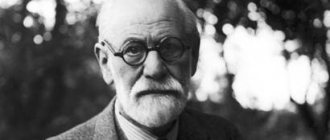Why is personality psychology needed?
The psychology of human personality has long gone beyond the “narrow direction”, and is of interest to both specialist psychologists and ordinary people. The reason is that a person wants to study himself and society, wants to be able to interact with different social groups, understand himself and the people around him - after all, this is one of the central concepts in life, the key to achieving mental and social comfort.
Therefore, since ancient times, scientists have sought to study the psychology of human personality and its impact on society. We can say that the conclusions, the discoveries that scientists have come to today are an example of the growth and maturation of the human personality over the centuries.
By getting to know oneself, a person gets to know the world around him and society. There are many ways to find yourself:
Personality psychology studies human behavior, emotions, and feelings in certain situations. In fact, each individual is “his own psychologist,” since he daily analyzes the behavior of others and his own.
Personality in psychology
Perhaps, in this case, there is no universal definition of personality in psychology. The existence of a person in itself is a complex and multifaceted phenomenon. Therefore, each definition deserves to be supplemented - this explains the abundance of scientific approaches to the concept of what a person is. Moreover, at different times and stages in the development of psychology, scientists have put forward different dominant theories.
For example, in Soviet psychology at the beginning of the twentieth century, personality was perceived as a set of certain psychological functions. Since the 30s of the twentieth century, personality has been transformed into “the experience of life and activity.” In the 50s, the concept of personality appeared in psychology: “temperament and age,” and since the 60s, personality began to be defined as the totality of a person’s relationships, which manifests itself in different areas of his activity.
Definition of personality
At the moment, there are several universal, most common concepts:
- Personality is the difference between one person and another in terms of internal qualities, which comprise individuality. A broad understanding that includes the characteristics of an individual’s psychological structure and the structure of his personality. That is, everyone is considered as an individual.
- Personality is a combination of personal and social roles. Such an average understanding of personality implies the need to be in society. That is, only society can provoke personal growth. The author of this definition is George Herbert Mead, an American psychologist. The definition is also close to Adler, who believed that the beginning of personality is in social feeling.
- A person is a cultural subject capable of managing his life and taking responsibility for it. The narrowest understanding is characteristic of existentialist psychologists - Jung, Leontiev. That is, we are talking about a source of personal energy. Based on this, an individual becomes a person not from birth, but in the process of growing up.
Important! Personality traits are the ability to cognition, the ability to experience, as well as empathy, the ability to influence the world around us and contact it.
Focus
Perhaps one of the main psychological properties of a person is direction. It includes such important components as:
- Needs
- Motives
- Goals
In fact, direction is nothing more than their unity, which determines the nature of the individual’s activity.
In turn, needs represent the need of a person - if we consider it from the point of view of a socio-biological being in a formed material or spiritual object.
As you know, needs require satisfaction. This is what motivates a person to the necessary activity, which implies a certain activity.
Psychological structure of personality
It is a set of psychological, biological and social properties. Such “building” allows you to objectively analyze the personality, considering each group separately.
Personality properties in psychology should be considered in separate directions:
Mental properties
Here's something to consider:
Temperament
Temperament is a set of properties that reflect the dynamics of a person’s mental processes. Features of temperament include a tendency to certain types of behavior in different conditions. It determines how strongly and quickly a person reacts to different events. We can say that temperament is in the closest connection with character, shaping human behavior.
The accepted division of temperaments belongs to Hippocrates. An ancient Greek philosopher who lived in the 5th century BC. e., identified the following types of temperament:
- Melancholic. This type is typical for vulnerable people with a complex inner life. Melancholic people get tired quickly, since they have a small energy reserve, and need frequent rest and solitude, since they attach great importance to all the events that happen to them.
- Choleric. This type is characterized by hot temper and lack of restraint, as well as stable, sustainable interests. Choleric people quickly get excited, but just as quickly calm down if the situation improves in their favor.
- Phlegmatic. Characteristic of cold-blooded individuals, patient, prone to passivity. Phlegmatic people are not known for their temper, but it is much more difficult for them to regain balance after a conflict. Personalities of this type are characterized by slow adaptation to new conditions, but at the same time they are distinguished by high efficiency.
- Sanguine. Sanguine people are the easiest type, since they get along with others without problems due to their optimistic attitude and penchant for humor. Such a person always has a lot of energy and tirelessly implements his plans, easily adapting to new conditions.
Currently, there are many ways to determine your temperament. Knowing the characteristics of your temperament allows you to achieve comfort in life.
Character
Character is the unity of individual traits that characterize the behavior of an individual. Character expresses an attitude towards life.
Groups of character traits:
- The fundamental principle of personality. For example, sincerity, secrecy, courage and uncertainty.
- Attitude towards others: respect, disrespect, anger, care and neglect.
- Traits that determine the attitude towards oneself are arrogance, meekness, pride, self-criticism, etc.
- Perception of work activity. For example, work activity or laziness, a sense of responsibility or its absence, passivity.
They also distinguish between normal properties - these are all the above properties that are natural, and abnormal ones - characteristic of mental illness. For example, excessive suspicion, turning into paranoia. Or jealousy, leading to the emergence of “Othello syndrome”.
Focus
Direction is an established system of motives, which is characterized by the level of maturity and determines the behavior of the individual.
The features of this property are the social significance of personal relationships (their level of social value), purposefulness (diversity of needs), integrity (degree of stability).
Direction determines the behavior of an individual.
Capabilities
Abilities are inclinations that can be developed in a particular direction. As a rule, they are measured by the concepts of giftedness, talent and genius.
Giftedness is the presence of inclinations that are present in a person from birth.
Talent is potential that is revealed through talent and work on abilities.
Genius is the highest level of talent development, meaning complete mastery of an ability.
Abilities are divided into:
- Elementary - for example, the ability to distinguish colors, hear sounds.
- Complex - related to activities in a particular area. For example, mathematical (the ability to solve complex problems), art, music, and so on. Abilities are socially conditioned. This means that a person is not born with these abilities, but with the presence of inclinations that he can develop.
Abilities are also divided according to the following criteria:
- General - motor or mental. These abilities are different for each person.
- Special - for implementation, inclinations are required (sports, acting, etc.). These abilities help a person to realize himself in a particular field of activity.
Mental processes
These are stable formations formed under the influence of external living conditions.
Are divided into:
- Cognitive. This is a process of sensory (using the perception of sensations) and abstract-logical (using thinking, imagination) reflection of reality.
- Emotional. Emotions are individual experiences of a pleasant or unpleasant nature.
Types of emotions:
- One of the key concepts characterizing the property is mood, reflecting the state of a person in a certain period.
- Another concept is feelings, which contain a range of emotions and are aimed at some object.
- Affects are violent but short-lived emotions that actively manifest themselves externally in a person’s gestures and facial expressions.
- Passion is a vivid emotion that is often impossible to control.
- Simple emotions - caused by the satisfaction of simple needs. For example, the pleasure of delicious food.
- Stress is a combination of emotions with a special physical state of the body.
Emotions are an important part of personality, and vary among people of different temperaments and characters. They are able to have a strong influence on the life of a person, who often makes decisions under the influence of certain feelings. A distinctive feature of emotions is their inconstancy and frequent change.
Will is the ability of an individual to control his psyche and actions.
The peculiarity of this property is that for its manifestation it is necessary to make an effort and overcome any obstacles, since willpower is associated with making reasonable decisions.
This means the ability to limit oneself to achieve a certain goal, as a result of which a person receives not emotional, but moral satisfaction (ultimately) from the manifestation of the property.
Willpower helps you manage your weaknesses and get rid of them. But to possess this property, you first need to develop it through training: setting goals and achieving them.
The concept of will is inextricably linked with the concept of motivation.
Motivation is a set of physiological or psychological urges that determine the behavior of an individual.
This is a property of an incentive nature, responsible for the activity and direction of behavior. Social attitudes are of great importance here, since they are primarily perceived by society.
The following factors influence motivation:
- need - a state in which a person needs something that can ensure existence and development;
- stimulus - a factor (external or internal) that programs to achieve a goal;
- intention - a decision that is made consciously, with the desire to achieve the intended goal;
- urge is an unconscious desire that prompts a person to take urgent action.
Psychic formations
These are mental phenomena with the help of which life and professional experience is formed.
The content of mental formations includes:
- Knowledge is information obtained as a result of historical experience. Knowledge has practical and theoretical significance. Knowledge is also divided into “pre-scientific” - inaccurate, built on assumptions, “extra-scientific” - those that are unsubstantiated by science, and “scientific” - proven and confirmed by science. There is also a distinction between theoretical knowledge, consisting of information about the state of the surrounding world, and practical knowledge - information about the ways of using objects in the surrounding world.
- Skills are actions that are formed through repetition and are the result of mastery. As a rule, it can be developed in the absence of conscious regulation of the process as a result of training and exercise. For example, developing the skill of fast reading.
There are perceptual (sensation), intellectual (analysis of sensations) and motor skills.
- Skills. Proven and effective ways of performing actions based on acquired skills and knowledge. To develop skills, it is not necessary to perform exercises and training.
- Habits. An established way of behavior, a learned action that acquires the character of a need.
Having examined the mental side of the structure, let us move on to studying its social side.
Temperament
Continuing our consideration of the psychological properties of personality, we gradually approached temperament. Temperament conveys the dynamic characteristics of human behavior and activity. According to Pavlov, temperament is nothing more than an innate characteristic of the nervous system. In other words, genotype.
There are four types:
- Cholerics
In short, it is characteristic of those who are hot-tempered, unrestrained, impatient and impulsive. But at the same time, if they are met halfway, they can quickly “stabilize” their condition. They are characterized by persistence and stability in their interests and aspirations.
- Sanguines
It is typical for optimists and jokers. Sanguine people are sociable, which allows them to quickly build bridges of communication with other people. They can work a lot and for a long time. They take on new things easily.
- Phlegmatic people
It is quite difficult for them to rebuild in a new way and adapt to a new environment. They find it difficult to break old habits. They are slowly excitable, but at the same time they need a lot of time to “cool down”. With everything, phlegmatic people are quite energetic and efficient. They are characterized by endurance and self-control.
- Melancholic people
These are gloomy people with permanent internal tension. Their distinctive features: vulnerability, anxiety, restraint. Even minor difficulties can pull the rug out from under their feet, and they immediately give up.
Social structure of personality
These are social properties in communication and life.
Directions characterizing this structure:
- Components of the structure according to the 1st approach:
- Memory is the totality of acquired knowledge.
- Culture is the unity of social norms. And also social values.
- Activity is the influence that a person is capable of exerting in relation to various objects.
- The second approach involves revealing the concept of personality in 2 directions:
- Objective approach - “status + social role”.
- Subjective - following legal and cultural norms.
- The 3rd approach allows us to consider social. structure as a unity of possibilities:
- possibility of purposeful activity;
- thinking and analysis;
- regulation of needs; manifestations of abilities;
- having a certain social role, status;
- possession of value orientations;
- possession of cultural knowledge and beliefs, legal norms.
Important! Social structure is characterized by continuous change, which occurs as a result of changes in the social environment and the receipt of new information. In turn, new knowledge influences beliefs, affecting the behavior of the individual.
Consequently, the social development of the individual is impossible in a social vacuum. Fear of contact with society is called social phobia:
Emotions
Emotions are a mental reaction to any events. An emotional reaction is always subjective and has nothing to do with objective facts. Emotions are associated with the individual needs of the individual, as well as beliefs and experiences.
By type, emotions can be positive or negative. The first includes joy, passion, enthusiasm, faith, optimism, hope, satisfaction. The second - boredom, irritation, disappointment, anxiety, despondency, fear, sadness, excitement.
Psychologist B.I. Dodonov proposed the following classification of emotions according to the specifics of the situations in which they arise:
- communicative;
- altruistic;
- practical (occurs after the successful implementation of the plan);
- gloric (associated with the need for self-affirmation);
- fearful (occurs in situations of risk, danger);
- romantic;
- aesthetic;
- Gnostic (associated with the desire for knowledge);
- active (associated with accumulation, gathering);
- hedonistic (associated with any pleasures).
Emotions are situational experiences. They are short-lived. If you continue to experience the same thing after the situation ends, then this is the feeling. However, in practice, the first and second are often identified.
Personality structure according to Rubinstein
According to theory, it is necessary to have 3 components of personality:
- Directionality. It includes a person’s needs, as well as beliefs, interests and attitude. Direction contains the concept of “I” and the social essence of the individual.
- Mental formations. Thanks to the acquired knowledge, skills and abilities, a person is oriented in the outside world and achieves good results in various types of activities.
- Individual properties of a typological nature are manifestations of character, temperament and abilities. Individuality is formed through these factors.
Thus, personality psychology is formed through relationships with the outside world and society.
Important! Rubinstein distinguishes the vital, personal and mental level of human organization. The life level appears in the process of accumulating experience, the personal level consists of individual characteristics, and the mental level consists of the activity of mental processes.
According to Rubinstein, the correlation of all levels creates a mentally healthy, socially adapted person.
Definition of concepts
This section of psychological science combines the most important concepts for studying the internal connections and mental processes of an individual. At the same time, different psychologists offer different approaches to what is the object of research. For some, this is a single representative of humanity, who is the bearer of consciousness. For others, it is the same, but as an element of social relations. In this regard, a generalized definition is born that understands a person as a being distinguished by conscious mental activity and being a subject of social interactions.
PL Items
- temperament;
- moral aspects;
- individual's motives;
- intellectual characteristics;
- roles in society.
What is personality: a brief definition in psychology
In simpler terms, this is a combination of the following properties:
- abilities (mental and physical internal resources);
- character (that which shapes behavior and views on the world);
- worldview (a special vision of reality and individual attitude towards it);
- emotionality (expression of reaction to external stimuli);
- focus (the ability to determine values and guidelines, set goals and achieve them);
- general portrait (external features - gait, habits, facial expressions, gestures);
- temperament (unchangeable attitudes that influence the formation of behavioral factors - melancholy, choleric, phlegmatic, sanguine);
- motivation (what determines a person’s actions);
- experience (acquired skills and knowledge).
Personality structure according to Platonov
The Soviet specialist in the field of psychology takes the personality to be a dynamic system. This system changes over time, new elements are included, but the same functions are retained.
According to Platonov’s theory, the personality structure is hierarchical and has four substructural levels, which are arranged in the shape of a pyramid:
- The substructure of biopsychic conditioning is the base for the pyramid. These are biochemical characteristics, genetics and physiology. That is, those properties of the body that support human life. This may include gender, age, and pathologies.
- Substructure of individual characteristics. It is associated with the cognitive process, that is, it depends on factors such as perception, memory, attention, sensation and thinking. The development of display forms gives a person the opportunity to increase activity, observation, and improve orientation in social space.
- The substructure of experience is the social characteristics of a person. That is, these are his mental formations (knowledge, skills), which he acquires through experience in communicating with people around him.
- The substructure of orientation is determined by the formation of moral traits, a person’s worldview, beliefs and ideals. Motivation arises through desire and desire. Consequently, the fourth substructure is necessary for a person in order to determine his actions, work, and hobbies.
This is interesting
The experimental method is subject to widespread criticism for reasons of humanity, but its results always turn out to be the most reliable and interesting for science. For example, Stanley Schachter conducted a very interesting experiment, during which it was found that in an emergency, life-threatening situation, a person prefers to be not alone, despite the understanding of joint death. Further research showed that a person prefers to be close to someone who experiences the same fears or emotions as him. That is, in a threatening situation, a person needs not just a friend, but a “suffering” friend.
Based on the conducted personality studies, it is possible to reliably determine all the criteria and indicators of a person’s psyche in order to create a holistic personal portrait.
Personality structure according to A. N. Leontiev
The Soviet psychologist-educator believed that personality is not limited to the framework of relations with the world.
A. N. Leontyev clearly separated the concepts of the individual and personality. If the first means a set of biochemical processes and consists of systems of organs and functions, then the second does not depend on the individual, since it arises in the process of life, gaining experience, and being in society.
There is also a hierarchical structure here, which can be represented as an inverted pyramid:
- The foundation of the structure is human activity that determines his life. These are relationships and actions of the subject, which, however, do not always contribute to development. They are also external in nature, without having a significant impact on the structure of the structure.
- The second level characterizing personality is the establishment of a hierarchy of motives.
- The top of the inverted pyramid, which is also its base, since at this level the life goal is established. The completion of the structure will be a monovertex or polyvertex type of structure. It depends on how many motives there are and which are the most important. The entire viability of the structure depends on the goal set.
Consequently, the main quality of this structure is the built hierarchy of motivational actions, since the activity depends on the motive.
Also, according to Leontiev, 3 more parameters are distinguished:
- how widely a person interacts with the world around him;
- the extent to which these relationships are hierarchical;
- and what the resulting joint structure of these relationships looks like.
Important! According to A. N. Leontiev, personal structure does not depend on the structure of the individual.
In contrast to the theories of the best Soviet minds and to enrich the understanding of the global development of psychology, let us consider the American idea of personality structure.
Capabilities
Abilities are innate data. To be more precise, from birth we are given inclinations, and in the future it depends on the conditions of human development whether they develop abilities or not. Inclinations are anatomical and physiological features of the nervous system that serve as the basis for the formation of abilities. Abilities are personality traits that help one achieve greater success in performing any activity compared to other people.
Abilities can be biologically determined (given by nature) and socially acquired (specific abilities). In addition, in psychology it is customary to distinguish the following types of abilities:
- Are common. They help you achieve success in any type of activity. Examples of general abilities: good memory, high stability of attention and mental agility.
- Specialized. Increase the chances of success in mastering a specific activity. Examples: musical ear, artistic taste.
Among the special abilities are the following types:
- musical,
- artistic,
- sports,
- literary,
- creative,
- educational,
- intellectual,
- mathematical,
- others.
On the subject of interaction, it is customary to distinguish the following abilities:
- interpersonal – a person easily establishes social contacts;
- subject - a person is better able to interact with objects than with people.
In addition, theoretical and practical abilities are distinguished. In the first case, a person is more inclined to analysis and reasoning. In the second case, a person prefers to implement his activities through active actions.
According to the degree of development, abilities are reproductive (repeating someone else’s experience, knowledge) and inventive (creating something unique, new).











